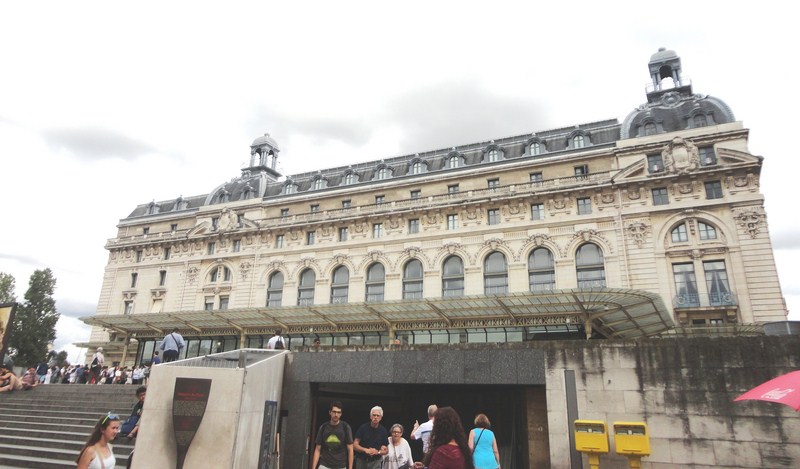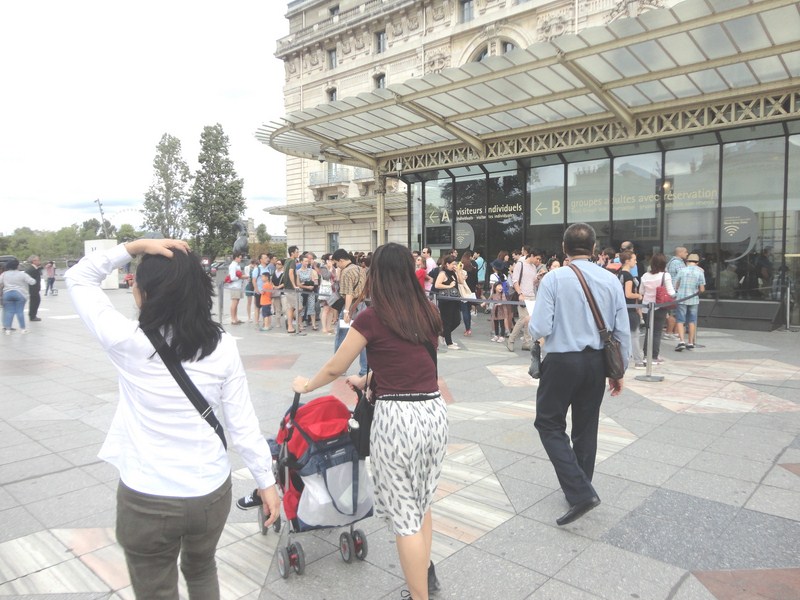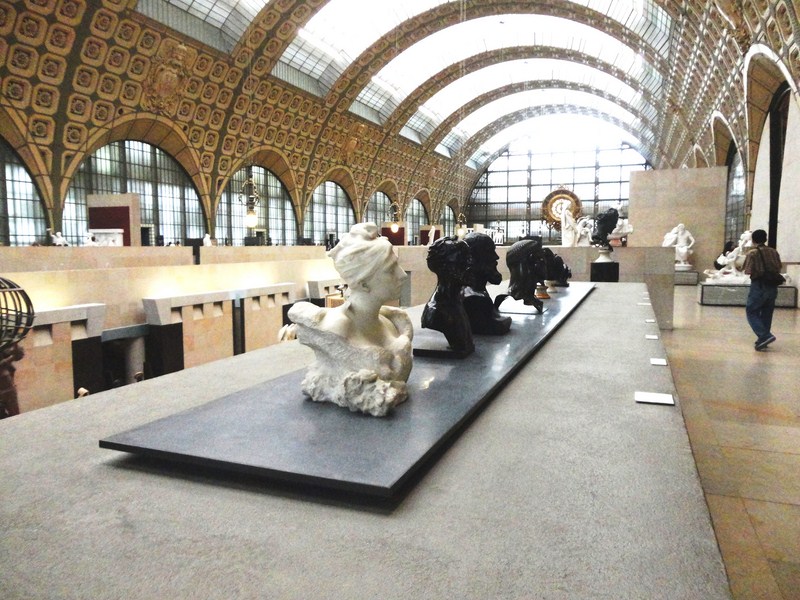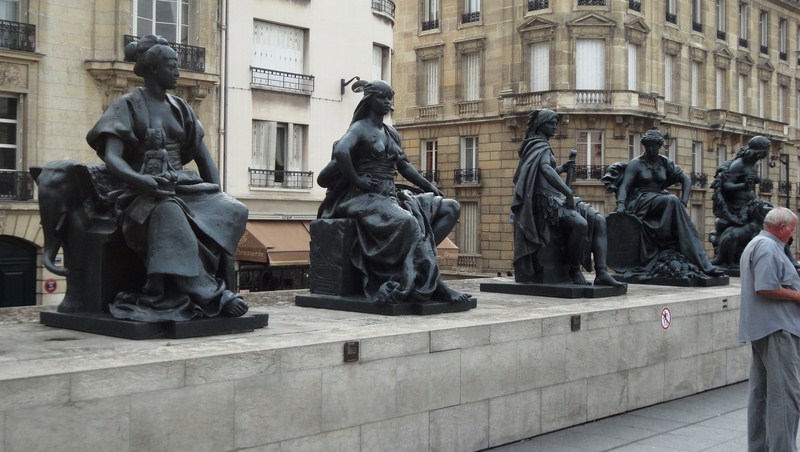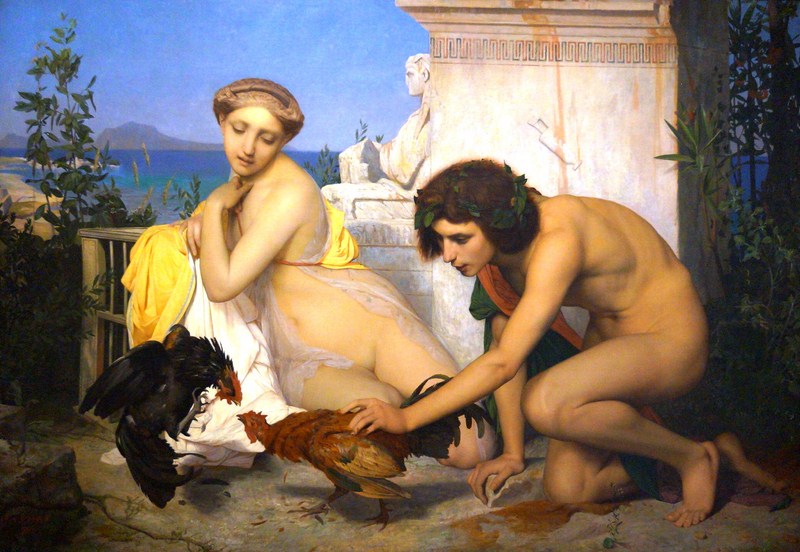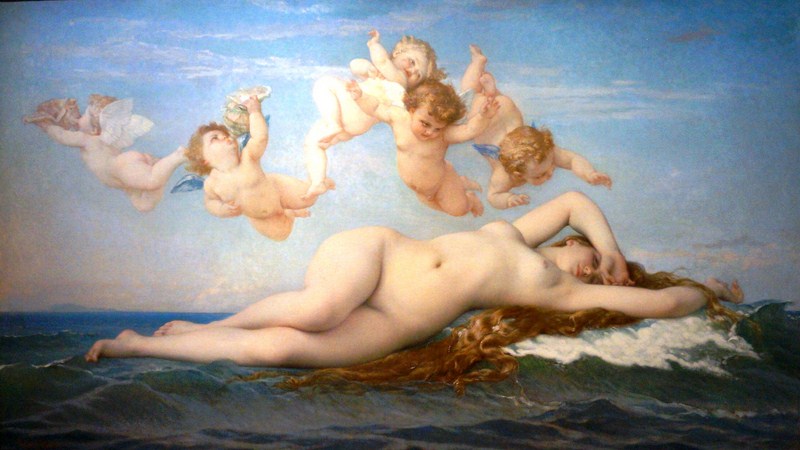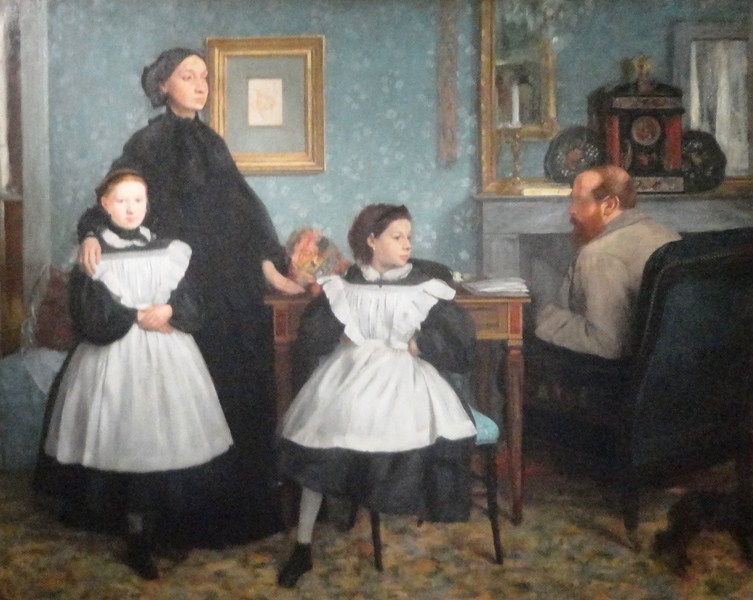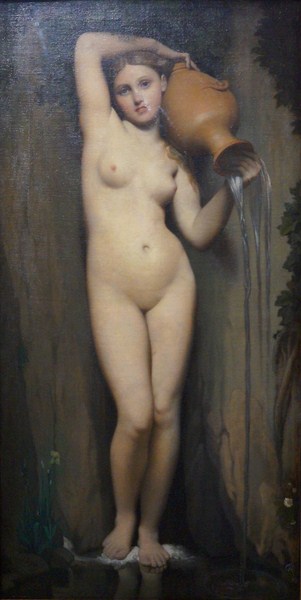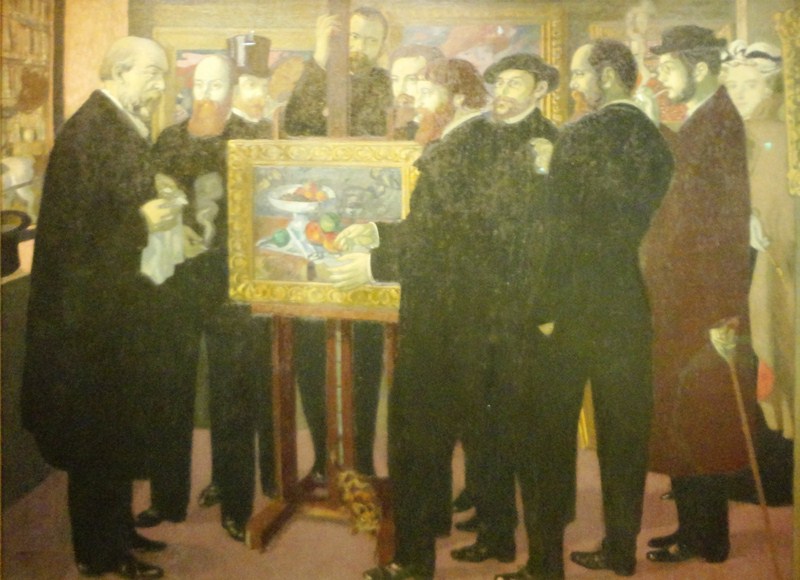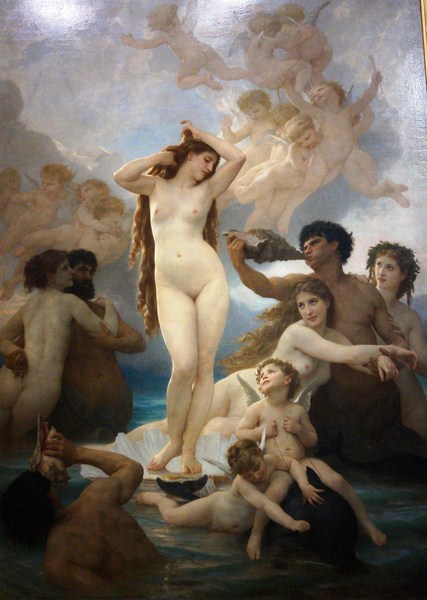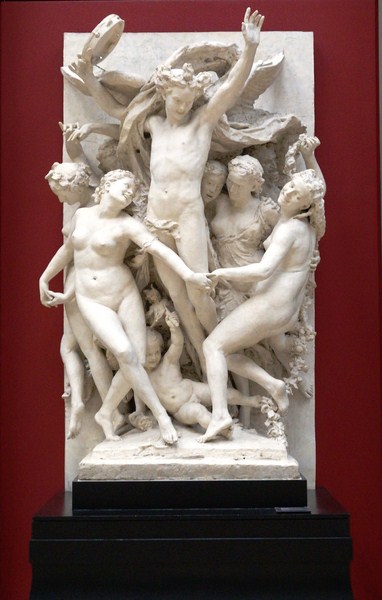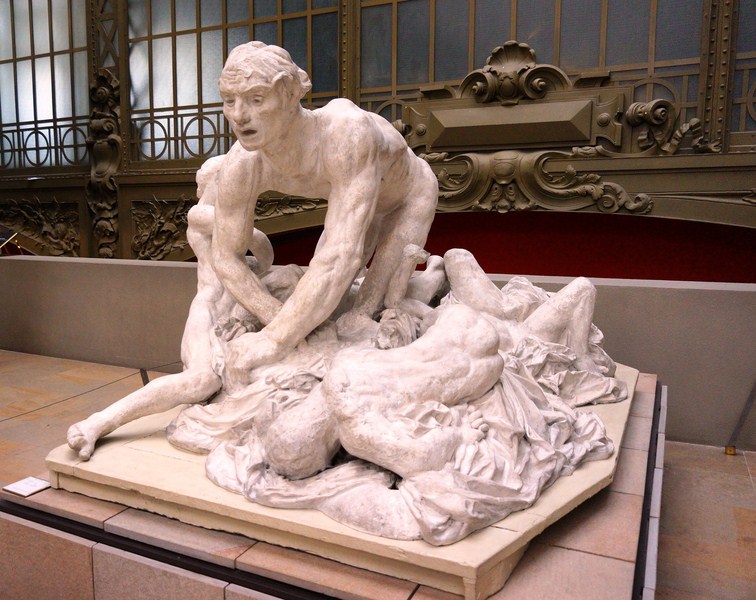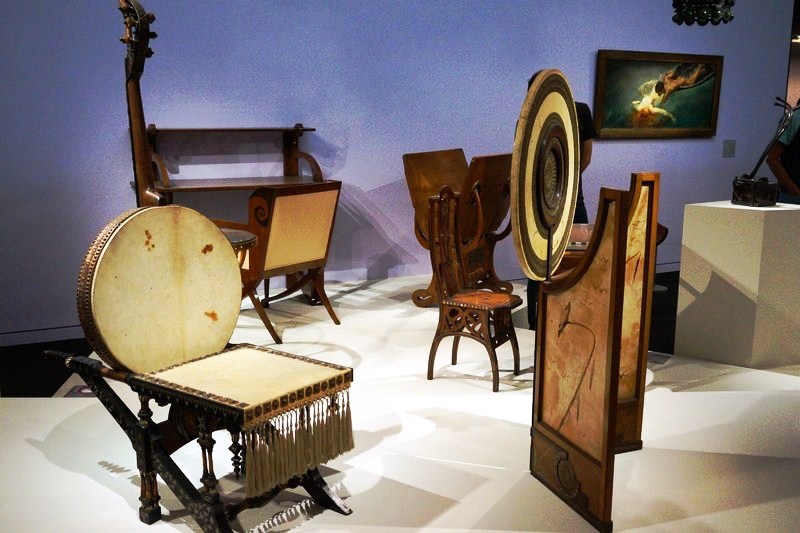The final leg of our first day tour of Paris was to be some art immersion at the Musee d’Orsay, located on the left bank of the Seine. From Les Invalides, we walked the short 1.4 km. distance to the museum via Rue de Varenne and Rue de Bellechasse. This museum is housed in the former Gare d’Orsay, a Beaux-Arts railway station, designed by architects Lucien Magne, Émile Bénard and Victor Laloux, and built between 1898 and 1900 for the Chemin de Fer de Paris à Orléans and finished in time for the 1900 Exposition Universelle.
The terminus for the railways of southwestern France . by 1939 the station’s short platforms had become unsuitable for the longer trains that had come to be used for mainline services and, after 1939, it was used for suburban services and part of it became a mailing centre during World War II. It was then used as a set for several films (such as Franz Kafka‘s The Trial adapted by Orson Welles), as a haven for the Renaud–Barrault Theatre Company and for auctioneers, while the Hôtel Drouot was being rebuilt.
In 1978, the station was put on the list of Historic Monuments and the Directorate of the Museums of France then decided to turn the station into a museum that would bridge the gap between the Louvre and the National Museum of Modern Art at the Georges Pompidou Centre. That same year, a competition was organized to design the new museum and ACT Architecture, a team of three young architects (Pierre Colboc, Renaud Bardon and Jean-Paul Philippon), were awarded the contract which involved creating 20,000 sq. m. of new floor space on four floors.
The construction work was carried out by Bouygues and, in 1981, the Italian architect, Gae Aulenti was chosen to design the interior including the museum‘s internal arrangement, decoration, furniture and fittings. In July 1986, the museum was finally ready to receive its exhibits and it took 6 months to install the 2,000 or so paintings, 600 sculptures and other works, many of which were formerly exhibited at the Galerie Nationale du Jeu de Paume. In December 1986, the museum was officially opened by Pres. François Mitterrand.
The museum now houses the largest collection of Impressionist and Post-Impressionist French art masterpieces in the world (mainly dating from 1848 to 1915). Its painting collection includes works by Monet, Manet, Degas, Renoir, Cézanne, Seurat, Sisley, Paul Gauguin and Vincent van Gogh.
At the square, next to the museum, are six bronze allegorical sculptural groups in a row, all originally produced for the Exposition Universelle (1878). They are “South America “ (Aimé Millet), “Asia” (Alexandre Falguière), “Oceania” (Mathurin Moreau), “Europe” (Alexandre Schoenewerk), “North America” (Ernest-Eugène Hiolle) and “Africa” (Eugène Delaplanche).
Major painters and their works represented include:
- 5 paintings of Eugène Delacroix
- 86 paintings (including The Painting Family, The Sick Child, Intimacy) of Eugène Carrière
- 5 paintings of Théodore Chassériau
- 48 paintings (including The Artist’s Studio, A Burial at Ornans, Young Man Sitting, L’Origine du monde) of Gustave Courbet
- 27 paintings (including Spring, The Gleaners) of Jean-François Millet
- 32 paintings (including A Morning, The Dance of the Nymphs) of Jean-Baptiste-Camille Corot
- 9 paintings of Johan Barthold Jongkind
- The Birth of Venus, The Death of Francesca da Rimini and Paolo Malatesta of Alexandre Cabanel
- Portrait of the baroness Nathaniel de Rothschild, Reception of Condé in Versailles, La Comtesse de Keller of Jean-Léon Gérôme
- Young Girls by the Seaside, The Young Mother also known as Charity, View on the Château de Versailles and the Orangerie of Pierre Puvis de Chavannes
- 8 paintings of Gustave Moreau
- 8 paintings of Honoré Daumier
- 33 paintings (including Trouville Beach) of Eugène Boudin
- 46 paintings (including White Frost) of Camille Pissarro
- 34 paintings (including Olympia, The Balcony, Berthe Morisot With a Bouquet of Violets, The Luncheon on the Grass) of Édouard Manet
- 9 paintings of Berthe Morisot
- 43 paintings (including The Parade, also known as Race Horses in front of the Tribunes, The Bellelli Family, The Tub, Portrait of Édouard Manet, Portraits, At the Stock Exchange, L’Absinthe) of Edgar Degas
- 56 paintings (including Apples and Oranges) of Paul Cézanne
- 86 paintings (including The Saint-Lazare Station, The Rue Montorgueil in Paris. Celebration of June 30, 1878, Wind Effect, Series of The Poplars, Rouen Cathedral. Harmony in Blue, Blue Water Lilies) of Claude Monet
- 46 paintings (including Inondation at Port-Marly) of Alfred Sisley
- 44 paintings of Armand Guillaumin
- 6 paintings of Frédéric Bazille
- 1 painting of Mary Cassatt
- 106 paintings (including Caliban) of Odilon Redon
- 81 paintings (including Bal au moulin de la Galette, Montmartre) of Pierre-Auguste Renoir
- Der Holzfäller(The Woodcutter) of Ferdinand Hodler
- 7 paintings (including The Floor Scrapers) of Gustave Caillebotte
- The Dream of Édouard Detaille
- 24 paintings (including Self Portrait, portrait of his friend Eugène Boch, The Siesta, The Church at Auvers, View from the Chevet, The Italian Woman, Starry Night Over the Rhone, Portrait of Dr. Gachet,Bedroom in Arles) of Vincent van Gogh
- 24 paintings (including Tahitian Women on the Beach) of Paul Gauguin
- 4 paintings of Jean Auguste Dominique Ingres
- 18 paintings of Henri de Toulouse-Lautrec
- Proletarian Lodgings of Eugène Jansson
- 10 paintings (including The Cypresses in Cagnes) of Henri-Edmond Cross
- 16 paintings (including Women at the Well) of Paul Signac
- 6 paintings of Théo van Rysselberghe
- Misia at Her Dressing Table of Félix Vallotton
- 19 paintings (I of cluding The Circus) of Georges-Pierre Seurat
- 70 paintings of Édouard Vuillard
- 3 paintings of Henri Rousseau
- 60 paintings (including The Chequered Blouse) of Pierre Bonnard
- The Talisman, the Aven River at the Bois d’Amour of Paul Sérusier
- Portrait of the Artist Aged Eighteen, Princess Maleine’s Minuet or Marthe Playing the Piano, The Green Trees or Beech Trees in Kerduel, October Night of Maurice Denis
- Charing Cross Bridge ( also known as Westminster Bridge) of André Derain
- 1 painting of Edvard Munch
- 1 painting of Gustav Klimt
- 2 paintings of Piet Mondrian
- 3 paintings (including Arrangement in Grey and Black: The Artist’s Mother, also known as Whistler’s Mother) of James McNeill Whistler
- Sita and Sarita (Jeune Fille au Chat) of Cecilia Beaux.
- The Birth of Venus of William-Adolphe Bouguereau
Major sculptors includes François Rude, Jules Cavelier, Jean-Baptiste Carpeaux, Auguste Rodin, Paul Gauguin, Camille Claudel, Sarah Bernhardt and Honoré Daumier.
Also featured are works of Ernest Christophe, Antonin Carles, Alfred Charles Lenoir, Emile-Antoine Bourdelle, Louis Ernest Barrias, Joseph Bernard, Alexandre Falguière, Antoine-Auguste Préault, Antoine Louis Barye, Henri Chapu, Aristide Maillol, Clara Rilke-Westhoff, Auguste Clesinger, Frédéric-Auguste Bartholdi (best known for designing the Statue of Liberty), Albert Carrier-Belleuse, Jules Salmson, David d’Angers, Andre-Joseph Allar, Jean Dampt, Charles Degeorge, Denys Puech, Paul Dubois. Jean-Léon Gérôme and Jean-Baptiste Hugues,
Aside from paintings and sculptures, it also holds collections of architecture, furniture, decorative arts and photography.
Musee d’Orsay: 1 Rue de la Légion d’Honneur, 75007 Paris, France. Tel: +33 1 40 49 48 14. Website www.musee-orsay.fr. Open Tuesdays, Wednesdays, Fridays, Saturdays and Sundays, 9 AM to 6 PM, Thursdays, 9:30 AM to 9:45 PM. Rooms begin closing 30 minutes before museum closing time, The museum is closed on Monday and the following French holidays: December 25 and May 1. Admission (adults): €11. Reduce price of €8.50 for 18-25 years who are not nationals of the European Union. Admission is free for those under 18 and 18-25 years old from European Union.
How to Get There: Via Subway 12, stop at Solferino, for RER C, stop at Musée d’Orsay, Bus 24, 63, 68, 69, 73, 83, 84 and 94,

